Articles
Top 25 most popular 2009 genealogy blogs
May 11, 2009 by Chris
Filed under Articles, Latest News, Public Records
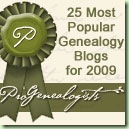 ProGenealogists recently announced their “25 Most Popular Genealogy Blogs for 2009” awards. We are very honored to be part of this group. A glance through the other blogs on the list is truly humbling. It’s even more humbling to read ProGenealogists announcement, noting that “a Google search for genealogy blogs currently results in nearly half a million options, with over seven times that number for ‘family history’ blogs.” I’m not certain how to do a Google search that returns the number of blogs, but to search blog posts, try http://blogsearch.google.com .
ProGenealogists recently announced their “25 Most Popular Genealogy Blogs for 2009” awards. We are very honored to be part of this group. A glance through the other blogs on the list is truly humbling. It’s even more humbling to read ProGenealogists announcement, noting that “a Google search for genealogy blogs currently results in nearly half a million options, with over seven times that number for ‘family history’ blogs.” I’m not certain how to do a Google search that returns the number of blogs, but to search blog posts, try http://blogsearch.google.com .
At the time I wrote this article a search for the word genealogy returned 857,000+ blog posts containing the word genealogy. A search for “family history” (including the quotes), returns 674,000+ posts.
Subscribe to new Google Search results
The search results page contains one of my secrets for uncovering news stories that you won’t see on the other genealogy news sites. You can subscribe to the results of your blog search by clicking one of the options in the left margin under the heading, “Subscribe.” This will give you an email or news feed of all the new results for your search. That’s only 6,600+ articles you’ll have to read each day to cover all blog posts with either the phrase “family history” or the word “genealogy.” Better yet, let your favorite genealogy news blogs shift through all those posts while you use the email option, called a Google Alert, to set up a Internet-wide sweep for new information on those ancestors you’re trying to find!
And thank goodness the President’s choice for new First Pet is done. Several months ago Google changed their search algorithm. My Google alert for FamilySearch started returning results containing “…First Family searches for dog…” To prevent this behavior, include quotes around words you don’t want Google to break into separate words. But I digress…
Measurement Challenges
Choosing the 25 most popular genealogy blogs had special challenges not encountered when measuring the 50 most popular genealogy websites.
“Many people read blog entries through RSS feeds and other means and seldom actually visit the blog’s website,” according to Kory Meyerink, noted genealogist and vice president at ProGenealogist. Instead of website traffic, ProGenealogist turned to Technorati rankings. Even this alternative proved problematic, as Technorati doesn’t include Dick Eastman’s popular online blog/newsletters. This led ProGenealogist to include other factors:
Hundreds of genealogy blogs were evaluated based on their overall content, Technorati rating, and industry experience. Due to the ever-changing nature of the blogosphere and the authority basis of Technorati rankings, it is anticipated that this list will change frequently.
When I first started blogging years ago (has it really been that long?) I found my Technorati authority rating changed so erratically, I couldn’t stand to follow it. Since I seem to be in widget-mode of late, here’s a widget that displays my authority rating in real time:
View Ancestry Insider authority
Like other widgets I’ve posted lately, it is likely you won’t be able to see it (adjacent to “View Ancestry Insider authority”) if you read this article in your email or news reader. View this article online (click here) to see the widget.
The Technorati Authority of a blog is a count of the number of other blogs that have posted links to it during the previous six months. Since other winners of the most popular blogs award have increased my authority by posting the list of winners, I’m honored to return the favor. They are:
- About.com Genealogy (Kimberly Powell)
- Eastman Online Newsletter* (Dick Eastman)
- Genea-Musings (Randy Seaver)
- Creative Gene (Jasia)
- DearMYRTLE (Pat Richely)
- AnceStories (Miriam Midkiff)
- Genealogue (Chris Dunham)
- footnoteMaven (Anonymous)
- Genetic Genealogist (Blaine Bettinger)
- Tracing The Tribe: Jewish Genealogy Blog (Schelly Talalay Dardashti)
- GenaBlogie (Craig Manson)
- Olive Tree Genealogy Blog (Lorine McGinnis Schulze)
- Steve’s Genealogy Blog (Stephen J. Danko)
- Ancestry.com (Juliana Smith)
- TransylvanianDutch (John Newmark)
- GenDisasters (Stu Beitler)
- Genealogy Insider @ FamilyTree (Diane Haddad)
- Think Genealogy (Mark Tucker)
- California Genealogical Society and Library Blog (California Genealogical Society)
- The Genealogy Guys (George G. Morgan and Drew Smith)
- CanadaGenealogy, or, ‘Jane’s Your Aunt’ (Diane Rogers)
- Ancestry Insider (Anonymous)
- GenealogyBlog (Leland Meitzler)
- Ancestor Search Blog (Kathi)
- Genealoge (Hugh Watkins) /its a tie!/
Legacy News (Legacy Tree Software) /its a tie!/
(This posting is from The Ancestry Insider. Click the link to view the full article from its original source.)
1911 Census for England now completely online
April 11, 2009 by Chris
Filed under Articles, Latest News, Public Records
In the ev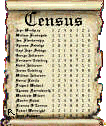 er changing world of online genealogy you have to keep an eye peeled for the latest BIG NEWS! Today’s top story: The 1911 census for England has finally been uploaded. Any one who has been looking for their Scottish ancestors down south will be thrilled to know that the England’s 1911 census is now available through FindmyPast.com at www.1911census.co.uk
er changing world of online genealogy you have to keep an eye peeled for the latest BIG NEWS! Today’s top story: The 1911 census for England has finally been uploaded. Any one who has been looking for their Scottish ancestors down south will be thrilled to know that the England’s 1911 census is now available through FindmyPast.com at www.1911census.co.uk
The next 1911 censuses in line for release are for:
- The Isle of Man
- All Welsh counties
- The Channel Islands
- Royal Naval ships at sea and overseas military establishments.
There is however a wait ahead for the Ireland 1911 census to be released, as it is a bit behind schedule. No word has been heard to explain the holdup from www.census.nationalarchives.ie. We will keep checking with Chris from Scotland’s Greatest Story as he promises to keep us informed and let us know as soon as he hears anything.
Accessing Military Records
March 8, 2009 by Chris
Filed under Articles, Genealogy Military Records, Genealogy Records 101, General Tips
 The following came from a current subscriber to Genealogy Beginner.
The following came from a current subscriber to Genealogy Beginner.
“Great advice: First I would like to let you know I enjoy your tips. As a beginner they have been very helpful. I know different states have laws in reference to military records. In the state of South Carolina military records are not public. The information can only be given to the individual, their Power of Attorney, or spouse. The SC state statute is very clear and states that the military records can only be used for genealogical research 50 years after the death of the person whose military records are referenced. I know this to be a fact because I work in the office where the military records are recorded in Aiken County, South Carolina.”
We have to be very cautious as to who has access to these documents.
Where to Next? Blank Family Tree Template
Ancestral Trails
January 23, 2009 by Chris
Filed under Articles, Latest News, Public Records

…
Where to Next?
Blank Family Tree with Step-by-Step Instructions
…
How to Make a Family Tree Chart
January 5, 2009 by Chris
Filed under Blank Family Tree, Genealogy Reports and Charts, Introduction to Genealogy
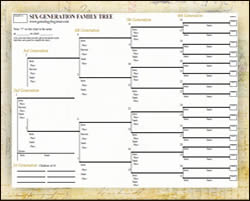 I received an email today where someone who had previously downloaded a family tree chart had written:
I received an email today where someone who had previously downloaded a family tree chart had written:
“Personally what I have trouble with is where to put people on the tree. Is each tree for each branch of the family? For instance, my husband has 3 siblings, my father-in-law has 3 siblings. Where do I stop on the tree? Having the cousins listed is important.”
This is such a comment type of question (and something that drove me crazy when I was first starting trying to figure out how to make a family tree chart). Let me post my reply here under the suspension that this might also be a question you’ve had (or have).
I replied …
XXX, thank you for writing,
You would find it helpful to review the family tree instructions. I wrote it to answer these specific questions. You can read about this download at the URL below:
https://www.genealogybeginner.com/blank-family-tree-template
Let me try to answer your question here as well. When making a family tree chart, Your family tree is only parents. Your children are the 1st generation, you are the second generation, your two parents the 3rd generation, your four grandparents the 4th generation, your eight great grandparents are the 5th generation, etc. So… you typically don’t include brothers, sisters, cousins, uncles, or aunts in YOUR family tree. The reason is that your family tree is a record of your direct ancestors. Your husband has a different set of ancestors. If you were to include your husband’s brother, for example, and that brother was married, your sister in-law’s parents would have no relation to you directly. Therefore, they don’t below on YOUR family tree.
Does that make sense? That said; there is no reason why you can’t create a separate family tree for your husband or a sister or cousin (as you suggest below).
Again, the URL above has a brief guide that covers some of the logistics around how to make a family tree chart and offers additional detail. If you decided to purchase it and it didn’t meet your needs, just let me know and I’ll refund your purchase right away.
Good luck,
Chris
Genealogy Beginner
https://www.genealogybeginner.com
Genealogy Trees | The Role of Cemeteries
December 31, 2008 by Chris
Filed under Articles, Cemetery Searches, Genealogy Cemetery Searches, Genealogy Records 101
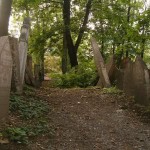 As regular readers of this site you know I’m a big fan of making sure cemetery research is a method used for researching your genealogy and family trees. Below is an example from Southern Graves (see link below for original post) on how we can find our past generations using cemetery search methods.
As regular readers of this site you know I’m a big fan of making sure cemetery research is a method used for researching your genealogy and family trees. Below is an example from Southern Graves (see link below for original post) on how we can find our past generations using cemetery search methods.
The author of the original post writes…
Mrs. Eliza B. R. Mendenhall died almost 160 years ago on December 29, 1848. She was 67 years of age at the time of her death, so her birth year was about 1781. She, along with her infant grandson John Bruce Limehouse, was interred in St. Philip’s Church Cemetery; Charleston, South Carolina.
I love the wording on this stone. In case you cannot read it via the photo, here is a transcription:
This marble marks the spot where repose
the remains of
Mrs. Eliza B. R. Mendenhall,
Who closed her earthly career on the 29th December A.D. 1848,
aged 67 years.
By her side sleeps her infant
grandson
John Bruce Limehouse.
“Thou art gone to the grave, but we will
not deplore thee
whose God was thy ransom, they Guardian
and Guide.
He gave thee, He took thee
and He will restore thee,
and death has no sting for the
Savior hath died.”
This stone is consecrated
to a beloved mother
by her daughter.
(This posting is from Southern Graves. Click the link to view the full article from its original source.)
As you can see from the transcription, there is a wealth of information to help us complete our family trees. Grave stones typically contain extensive records of birth and death dates. They also often cite family members.
By doing the math on age and date of death you can get the date of birth. While not cited here, you sometimes can discover where someone lived from a grave stone as well, which can lead to a local government office and a copy of a birth certificate (which, as you know, will reveal the parents and thus the next generation.)
Don’t overlook cemeteries in our work to build out your genealogy trees. They will save you a ton of time.
…
Where to Next?
Blank Family Tree with Step-by-Step Instructions
…
How to Do a Family Tree – Update on New Resource
December 30, 2008 by Chris
Filed under Blank Family Tree, Family Search The LDS, Genealogy Records 101
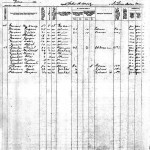 The Family Search website has added over 15 million new indexed records to its Record Search pilot, all from the 1850 and 1870 U.S. Censuses. The records are linked to the digital images of the originals. The new records can be searched for free at FamilySearch.org (Click Search Records, then Record Search pilot).
The Family Search website has added over 15 million new indexed records to its Record Search pilot, all from the 1850 and 1870 U.S. Censuses. The records are linked to the digital images of the originals. The new records can be searched for free at FamilySearch.org (Click Search Records, then Record Search pilot).
Chris
Scotland’s Greatest Story: www.ScotlandsGreatestStory.co.uk
Professional family history research & genealogical problem solving
(This posting is from Scottish Genealogy News and Events. Click the link to view the full article from its original source.)
…
Where to Next?
…
How to Make a Family Tree – The NARA
December 29, 2008 by Chris
Filed under Articles, Getting Started in Genealogy, Introduction to Genealogy, Public Records
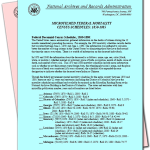
Below is a great article about how to make a family tree through the eyes of a first time visitor to the NARA. In it the author discusses the value of the color guides used to assist researchers with the NARA’s most common records. Make sure you visit the link below to visit the source of the guides online. These resources will surely help you figure out how to make a family tree.
I recently made my first visit to the National Archives and Record Administration (NARA). This is one in a series of articles inspired by that visit to help you make your first visit to the National Archives.
Colored sheet finding aids
National Archives staff have prepared over 160 pages of finding guides to assist researchers with their most common records. These guides are printed on various hues of colored paper. They can be found on a rack in the lobby once you arrive at the Archives.
Not 100% sure the purpose behind the color. These might have been a way to help them stand out or perhaps a coding system. If I learn more I’ll update this post.
While the National Archives has decided not to put these guides online, fortunately, the Mount Vernon Genealogical Society has decided to fill this void. The Mount Vernon Genealogical Society is located in the Washington, DC suburbs where society members are lucky enough to make frequent visits to the National Archives. Some members work there.
Harold McClendon, publicity chair for the society, says,
To make these sheets available to everyone, the Mount Vernon Genealogical Society is placing all of the guides on its web site in PDF format. The guides are organized into the following categories: African Americans, Asian Americans, Census, Citizenship, Civilian Federal Employees, District of Columbia, Early Congressional Private Claims, Immigration, lands, Military, Native American and 1885 State and Territorial Censuses. As new sheets are issued by the National Archives, copies are being added to the web site.
To access these finding aids, go to http://mvgenealogy.org/NARA_Guides.html. McClendon recommends printing the guides related to your research.
As you review the guide, you will then be better able to determine the specific publication to review in search of the desired records. You might even find that the National Archives has publications that you never knew existed.
Thank you, Harold McClendon and the Mount Vernon Genealogical Society for extending this service to the genealogical community.
(This posting is from The Ancestry Insider.)
Great information thanks to the folks at The Ancestry Insider. Use the link above to visit the original post directly and browse their site overall. When trying to figure out how to make a family tree every little bit of information helps.
…
Where to Next?
Blank Family Tree with Step-by-Step Instructions
…
Making A Family Tree – Graveyard Rabbits
December 11, 2008 by Chris
Filed under Articles, Cemetery Searches, Genealogy Cemetery Searches, Genealogy Records 101
 Making a family tree is never an easy undertaking. There are a lot of things to figure out and organize. However, regardless of where you are in the process of making your family tree you’ll find that knowing a bit about researching graveyards will make a huge difference. Today, I’d like to reference the works -as I’ve done often before – of Southern Graves who provides a great little story about the Graveyard Rabbit that I’m sure you’ll enjoy.
Making a family tree is never an easy undertaking. There are a lot of things to figure out and organize. However, regardless of where you are in the process of making your family tree you’ll find that knowing a bit about researching graveyards will make a huge difference. Today, I’d like to reference the works -as I’ve done often before – of Southern Graves who provides a great little story about the Graveyard Rabbit that I’m sure you’ll enjoy.
By way of introduction, the author writes:
My nickname in high school was “squirrel,” but it turns out I am really a rabbit. A Graveyard Rabbit, that is.
If you haven’t noticed the new statement in the heading, I am a charter member of The Association of Graveyard Rabbits. This group was founded by Terry Thornton, and she writes all about the name at her new The Graveyard Rabbit of the Hill Country blog. The short of it is the name came from a poem entitled The Graveyard Rabbit by Frank Lebby Stanton. My favorite lines of the poem are in the very beginning.
In the white moonlight, where the willow waves,
He halfway gallops among the graves –
A tiny ghost in the gloom and gleam,
content to dwell where the dead men dream…
This definitely describes my passion for cemeteries and the histories they share. Let’s break it down:
“In the white moonlight, where the willow waves”
I don’t visit cemeteries at night too much, only because it’s hard to read the stones and take pictures then! However, there are often live willows waving when I visit, as well as many stone willows standing tall.
“He halfway gallops among the graves”
At the risk of sounding silly, if I’m at a Cemetery I’ve never visited before, I often do the same thing! I go from stone to stone, in no kind of pattern, just to get a feel of the place. Plus, an interesting monument from afar gets my interest and I must check it out. I have to make myself at some point stop and systematically go through the graves for proper transcription, photographs, and to begin to get the full history of the Cemetery and those interred.
“A tiny ghost in the gloom and gleam”
I and my visit are but a tiny speck of the whole history of most cemeteries. Especially those that have been around for hundreds of years. There have been many visitors before me, and there will be many after me.
“Content to dwell where the dead men dream”
That statement is a simple fact that applies to me. I am very content walking among the headstones, reading them, photographing them, and learning from them.
I hope you will continue to join me on my journey through the cemeteries of the southern United States at the Southern Graves site and this Southern Graves blog.
Really great stuff, wouldn’t you agree? This is the type of story that makes genealogy and family history research so much fun. Sure, there is the process of hunting down certificates, finding dates and dealing with name changes but then there is also the rich history of the past written in stone. Grave Yard Rabbits are truly a wonderful group who I’m sure we will be revisiting in the future.
(This posting is from Southern Graves.)
…
Where to Next?
…
Family Tree Confusion
December 9, 2008 by Chris
Filed under Articles, Blank Family Tree, Genealogy Reports and Charts, Introduction to Genealogy

A little while ago we talked about the fact that there are a lot of family tree templates available online. Many of them are extremely fancy and can be very confusing. These decorative templates are great for presentation purposes; however, most people are looking for a simple solution and don’t want to spend endless hours trying to understand this box or that branch. I thought I would take this opportunity to describe my approach here at Genealogy Beginner.
